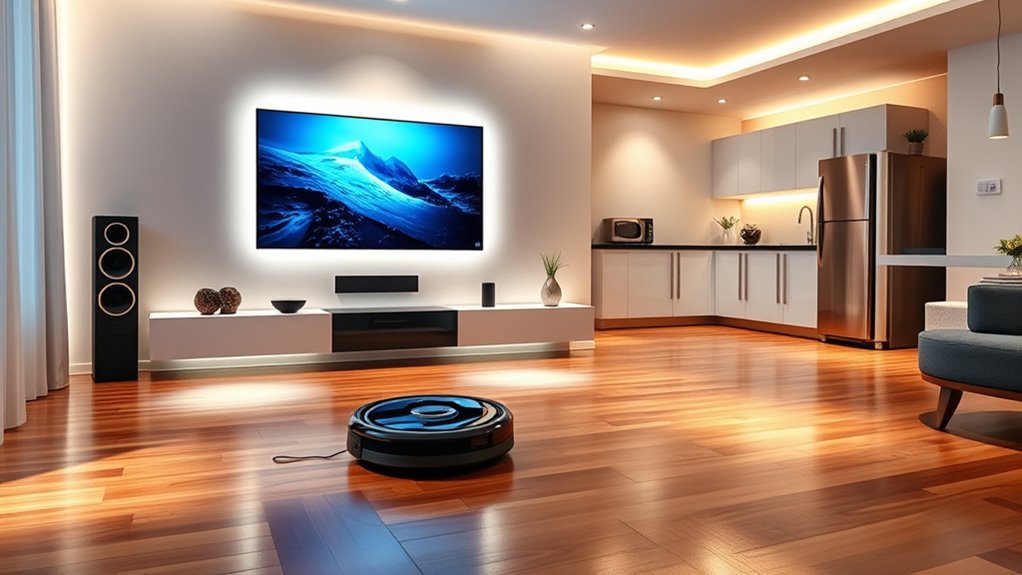In 2025, your home is smarter with advanced voice assistants that recognize multiple users and respond instantly. You’ll enjoy seamless automation for lighting, climate, and entertainment, all adapting to your habits. Energy management tools monitor and optimize usage, while renewable energy integrations lower costs and carbon footprints. These innovations make your home more comfortable, eco-friendly, and cost-effective. Keep exploring to discover how these cutting-edge features can transform your living space even further.
Key Takeaways
- Voice assistants become more personalized, recognizing multiple users with faster, natural language interactions for seamless control.
- Real-time energy monitoring and AI-driven optimization reduce costs and enhance sustainability through integrated renewable sources.
- Home automation systems create intuitive environments by connecting devices for automated lighting, climate, and entertainment adjustments.
- Smart sensors and automation minimize waste, improve efficiency, and support eco-friendly practices like solar energy use and home batteries.
- Enhanced responsiveness and continuous learning improve overall home comfort, convenience, and energy management in 2025.

Are you ready to see how smart homes are transforming in 2025? This year, home automation takes a giant leap forward, making everyday living more intuitive, efficient, and seamless. Voice control continues to be at the forefront, allowing you to manage your entire home with simple commands. Whether you want to dim the lights, adjust the thermostat, or play your favorite music, voice assistants like Alexa, Google Assistant, or Siri become smarter and more integrated. They now recognize multiple household members, respond faster, and understand more natural language, so you don’t have to remember exact phrases or commands. This shift means you can effortlessly control your environment without lifting a finger, creating a truly hands-free experience.
Energy management also gets a major upgrade in 2025. Smart homes now feature advanced systems that monitor and optimize energy usage in real-time, helping you reduce costs and lower your carbon footprint. Intelligent sensors track occupancy, lighting, and appliance activity, automatically adjusting settings to conserve energy when rooms are unoccupied or during off-peak hours. For instance, your smart thermostat learns your schedule and preferences, adjusting temperatures accordingly to keep your home comfortable while minimizing waste. These systems connect seamlessly with your utility providers, offering detailed insights into your energy consumption and even suggesting ways to improve efficiency. The integration of renewable energy sources, like solar panels and home batteries, further enhances energy management, allowing your home to generate, store, and use power more sustainably.
In 2025, the combination of voice control and energy management creates smarter, more eco-friendly homes that respond to your needs intuitively. Imagine walking into a room where the lights automatically adjust based on your voice command or presence detection, and the climate is perfectly set without you having to touch a dial. Your home’s AI-powered systems continuously learn your habits, optimizing energy use without sacrificing comfort. Additionally, high refresh rates in home tech devices improve responsiveness and user experience, especially in smart entertainment systems. This not only makes daily routines more convenient but also markedly reduces utility bills. As these technologies become more affordable and widespread, you’ll find yourself relying less on manual controls and more on integrated voice and smart systems that understand and anticipate your needs.
Frequently Asked Questions
How Will AI Personalize Smart Home Experiences in 2025?
In 2025, AI will make your smart home more personalized through advanced personalization algorithms and AI-driven customization. You’ll notice your devices adapt to your routines, preferences, and even moods automatically. These systems will learn your habits and adjust lighting, temperature, and entertainment settings accordingly. As a result, your home feels more comfortable, efficient, and tailored just for you, creating a seamless, intuitive living experience that evolves with your needs.
What Are the Security Challenges With Advanced Home Automation?
A stitch in time saves nine, and that’s true for your smart home security. As you embrace advanced home automation, you face cybersecurity vulnerabilities and privacy concerns. Hackers could exploit weak points, risking your personal data and home safety. Staying vigilant by updating software, using strong passwords, and enabling multi-factor authentication helps protect your devices. Remember, proactive security measures are your best defense against evolving threats in home automation.
Will Smart Homes Significantly Reduce Energy Consumption?
You might wonder if smart homes will considerably reduce energy consumption. The answer is yes, as they optimize energy use through automation, smart thermostats, and lighting controls. This leads to notable energy savings, which contribute to sustainability benefits. By adjusting energy consumption based on your habits and preferences, smart homes help lower utility bills and support environmental conservation, making your space more efficient and eco-friendly.
How Accessible Will Smart Home Technology Be for All Income Levels?
Imagine a key that opens every door—smart home tech holds that promise, but affordability barriers and income disparities can make it seem out of reach for many. As technology advances, prices are dropping, making it more accessible, yet gaps remain. You might find these innovations more within your grasp soon, but ensuring everyone benefits requires ongoing effort to bridge income disparities and make smart homes truly inclusive.
What Emerging Innovations Could Reshape Smart Home Living Beyond 2025?
You might see quantum sensors and holographic interfaces transforming your smart home beyond 2025. Quantum sensors could provide ultra-precise environmental data, optimizing your energy use and security. Holographic interfaces may allow you to control devices with intuitive gestures or even project virtual assistants into your space. These innovations promise to make your home smarter, more interactive, and seamlessly integrated into your daily life, revolutionizing how you live and interact with technology.
Conclusion
As you step into 2025, your home transforms into a seamless hub of innovation. Imagine waking up to gentle lighting that mimics sunrise, your smart thermostat adjusting to perfect comfort, and security cameras quietly watching over your sanctuary. With these cutting-edge trends, your living space becomes a haven of convenience and safety, wrapped in the soft glow of tomorrow’s technology. Embrace the future, where every moment feels effortless and your home responds like a trusted companion.









